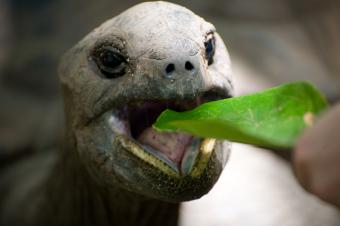
Turtles are adorable and make wonderful pets, but what can baby turtles eat? Those pet store pellets might be convenient, but what's in them? Now's your chance to find out what little baby turtles eat and how to supplement traditional turtle meals for optimal health.
Baby Turtles in Nature
A turtle can encounter many food sources while roaming in the wild, from deep swimming holes to shaded land, and they often do. Land turtles might swim in ponds or bogs where they'll find completely different types of food than when spending a day in the field. Since turtles are omnivores, the best-replicated turtle diet is of lean raw meat, grasses and greens, and the occasional fruit.
What Do Baby Turtles Eat?

The building block of your baby turtle's diet is the pellet or gel capsule supplement, which is a snap to find in any pet store that sells turtle supplies. There are two caveats, however: you should examine each label to make sure your newborn turtle is getting the best diet possible, and you should select a formula that's been approved for your particular shelled pet. For example, what a baby box turtle eats is more of a true omnivorous diet than a water turtle eats, which includes more raw meat as a baby but a more omnivorous diet as an adult.
Nutrient Balance for Feeding Baby Turtles
Here is a crude analysis of Tetra's ReptoMin that will give you an idea of the proper balance to look for:
- Crude protein not less than 40 percent
- Crude fat not less than 10 percent
- Crude fiber not more than 5 percent
- Ash not more than 9 percent
- Vitamin E not less than 160 International Units per pound, or IU/lb.
When examining the actual ingredients of a turtle pellet food, you'll find the following types of ingredients:
- Fish meal
- Corn
- Poultry
- Fish oil
- Meat meal
- Porcine meat meal
- Brewer's yeast
- Vitamin C
- Vitamin A
- Vitamin E
- Salt
- Zinc oxide
- Zinc sulfate
Healthy Additions to a Baby Turtle's Diet
You can feed your little pet pellets, but a varied diet is ideal and will help any turtle live a longer and happier life. Consider these inclusions in a growing turtle's diet, and you will find that your turtle grows faster, seems more alert, and has less trouble with mood regulation. Maybe that baby turtle of yours will even perk up when it sees you enter the room!
Suggested Live Foods for Baby Turtles
Suggested live foods include:
- Earthworms
- Slugs
- Snails
- Beetles
- Grasshoppers
- Crayfish
If you're wondering how to obtain any of these insects for your turtle, you simply need to ask at the pet stores for live feed for reptiles. They should have a selection of mealworms, crickets, and beetles that you can buy for your pet, and then all you need to do is bring them home and ration them out for your pet turtle.
You might also hear of the practice of feeding baby "pinky mice" to a young turtle. A pinky mouse is a baby mouse that has not grown fur or opened its eyes yet. The feeding of pinky mice is extremely controversial, and your turtle can feast happily on non-mammal prey as listed above.
How to Feed a Baby Turtle

When feeding your baby turtle pellet food, you should plan on feeding it once a day. Sprinkle pellet food on the top of the water, and feed only as much as your turtle will eat in 15 to 20 minutes. Any additional foods can be served in a small dish or on top of a rock, and it should be shredded small so it's easier to eat. This not only allows them to consume the food later, but maintains the cleanliness of their living space.
A Good Diet Makes the Difference for Your Baby Turtles
It's important to make sure you provide for the dietary needs of your pet as part of your overall care regimen. A baby turtle can survive on simple food like dried pellets, but if you really want him to thrive, you should always aim for a healthy mix that allows for seasonal availability, as well.







